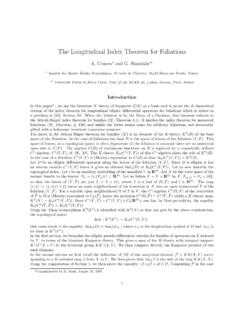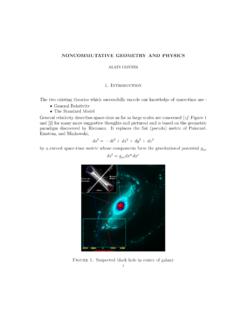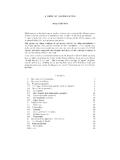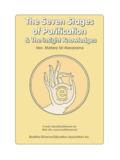Transcription of arXiv:hep-th/0605011 v3 20 Jun 2006 - Alain Connes
1 INNER FLUCTUATIONS OF THE SPECTRAL ACTION. Alain Connes AND ALI H. CHAMSEDDINE. Abstract. We prove in the general framework of noncommutative geometry that the inner fluc- tuations of the spectral action can be computed as residues and give exactly the counterterms for arxiv :hep-th/ 0605011 v3 20 Jun 2006 . the Feynman graphs with fermionic internal lines. We show that for geometries of dimension less or equal to four the obtained terms add up to a sum of a Yang-Mills action with a Chern-Simons action. Contents 1. Introduction 1. 2. Inner fluctuations of the metric and the spectral action 3. Pseudodifferential calculus 4. The operator Log (D + A)2 Log (D2 ) 5. The variation D+A (0) D (0) 8. 3. Yang-Mills + Chern-Simons 9. 4. Open questions 17.
2 Triviality of 17. Positivity 17. 5. Acknowledgment 17. References 18. We dedicate this paper to Daniel Kastler on his eightieth birthday 1. Introduction The spectral action is defined as a functional on noncommutative geometries. Such a geometry is specified by a fairly simple data of operator theoretic nature, namely a spectral triple ( ) (A, H, D), where A is a noncommutative algebra with involution , acting in the Hilbert space H while D is a self-adjoint operator with compact resolvent and such that, ( ) [D, a] is bounded a A . Additional structures such as the Z/2Z grading in the even case and the real structure J of H will play little role below, but can easily be taken into account. The spectral action fulfills two basic properties It only depends upon the spectrum of D.
3 It is additive for direct sums of noncommutative geometries. It is given in general by the expression ( ) Trace (f (D/ )), where f is a positive even function of the real variable and the parameter fixes the mass scale. The dimension of a noncommutative geometry is not a number but a spectrum, the dimension spectrum (cf. [6]) which is the subset of the complex plane C at which the spectral functions have singularities. 1. 2 Connes AND CHAMSEDDINE. Under the hypothesis that the dimension spectrum is simple that the spectral functions have at most simple poles, the residue at the pole defines a far reaching extension (cf. [6]) of the fundamental integral in noncommutative geometry given by the Dixmier trace (cf. [3]). This extends to the frame- work of spectral triples the Wodzicki residue (originally defined for pseudodifferential operators on standard manifolds) as a trace on the algebra of operators generated by A and powers of D so that Z Z Z.
4 ( ) P P C , P1 P2 = P2 P1 . Both this algebra and the functional ( ) do not depend on the detailed knowledge of the metric defined by D and the residue is unaltered by a change D D of D such that the difference Log D Log D, is a bounded operator with suitable regularity. In other words the residue only depends on the quasi- isometry class of the noncommutative metric. In this generality the spectral action ( ) can be expanded in decreasing powers of the scale in the form X Z. ( ) Trace (f (D/ )) k fk |D| k + f (0) D (0) + o(1), k +. +. where is the positive part of the dimension spectrum . The function f only appears through the scalars Z . ( ) fk = f (v) v k 1 dv. 0. One lets ( ) D (s) = Tr (|D| s ), and regularity at s = 0 is assumed.
5 Both the gauge bosons and the Feynman graphs with fermionic internal lines can be readily defined in the above generality of a noncommutative geometry (A, H, D) (cf. [2]). Indeed, as briefly recalled at the beginning of section 2, the inner fluctuations of the metric coming from the Morita equivalence A A generate perturbations of D of the form D D = D + A where the A plays the role of the gauge potentials and is a self-adjoint element of the bimodule X. ( ) 1D = { aj [D, bj ] ; aj , bj A}. The line element ds = D 1 plays the role of the Fermion propagator so that the value U ( n ) of one loop graphs n with fermionic internal lines and n external bosonic lines (such as the triangle graph of Figure 1) is easy to obtain and given at the formal level by, U ( n ) = Tr((AD 1 )n ).
6 These graphs diverge in dimension 4 for n 4 and the residue at the pole in dimensional regularization can be computed and expressed as Z. (AD 1 )n , as will be shown in [5]. In this paper we analyze how the spectral action behaves under the inner fluctuations. The main results are In dimension 4 the variation of the spectral action under inner fluctuations gives the local counterterms for the fermionic graphs of Figures 4, 2, 1 and 3 respectively 1 1 1. Z Z Z Z. D+A (0) D (0) = AD 1 + (AD 1 )2 (AD 1 )3 + (AD 1 )4 , 2 3 4. Assuming that the tadpole graph of Figure 4 vanishes the above variation is the sum of a Yang-Mills action and a Chern-Simons action relative to a cyclic 3-cocycle on A. INNER FLUCTUATIONS OF THE SPECTRAL ACTION 3.
7 A. A. A. Figure 1. The triangle graph. As a corollary, combining both results we obtain that the variation under inner fluctuations of the scale independent terms of the spectral action is given (cf. Theorem for precise notations) in dimension 4 by 1 1 2. Z Z. 2 2. ( ) D+A (0) D (0) = (dA + A ) (AdA + A3 ). 4 0 2 3. The conceptual meaning of the above tadpole condition is that the original noncommutative geometry (A, H, D) is a critical point for the ( -independent part of the) spectral action, which is a natural hypothesis. The functional 0 is a Hochschild 4-cocycle but in general not a cyclic cocycle. In particular, as explained in details in [3] Chapter VI, the expression Z. ( ) (dA + A2 )2 , 0. coincides with the Yang-Mills action functional provided that 0 0 that 0 is a positive Hochschild cocycle.
8 The Hochschild cocycle 0 cannot be cyclic unless the expression ( ) vanishes. We show at the end of the paper that the cyclic cohomology class of the cyclic three cocycle is determined modulo the image of the boundary operator B and that the pairing of with the K1 - group is trivial. This shows that under rather general assumptions one can eliminate by a suitable redefinition of 0 (see Proposition ). The meaning of the vanishing of together with positivity of 0 is that the original noncommutative geometry (A, H, D) is at a stable critical point as far as the inner fluctuations are concerned. In fact it gives in that case an absolute minimum for the (scale independent terms of the) spectral action in the corresponding class modulo inner fluctuations.
9 We end the paper with the corresponding open questions : elimination of and positivity of the 4-cocycle 0 . 2. Inner fluctuations of the metric and the spectral action The inner fluctuations of the noncommutative metric appear through the simple issue of Morita equivalence. Indeed let B be the algebra of endomorphisms of a finite projective (right) module E over A. ( ) B = EndA (E). Given a spectral triple (A, H, D) one easily gets a representation of B in the Hilbert space H = E A H . 4 Connes AND CHAMSEDDINE. But to define the analogue D of the operator D for B requires the choice of a hermitian connection on E. Such a connection is a linear map : E E A 1D satisfying the following rules ([3]). ( ) ( a) = ( )a + da , E , a A, ( ) ( , ) ( , ) = d( , ) , , E, where da = [D, a] and where 1D L(H) is the A bimodule ( ).
10 The operator D is then given by ( ) D ( ) = D + ( ) . Any algebra A is Morita equivalent to itself and when one applies the above construction with E = A. one gets the inner deformations of the spectral geometry. These replace the operator D by ( ) D D + A, where A = A is an arbitrary selfadjoint element of 1D where we disregard the real structure for . simplicity. To incorporate the real structure one replaces the algebra A by its tensor product A Ao with the opposite algebra. Pseudodifferential calculus. As developed in [6] one has under suitable regularity hypothesis on the spectral geometry (A, H, D). an analogue of the pseudodifferential calculus. We briefly recall the main ingredients here. We say that an operator T in H is smooth iff ( ) t Ft (T ) = eit|D| T e it|D| C (R, L(H)), and let OP 0 be the algebra of smooth operators.












